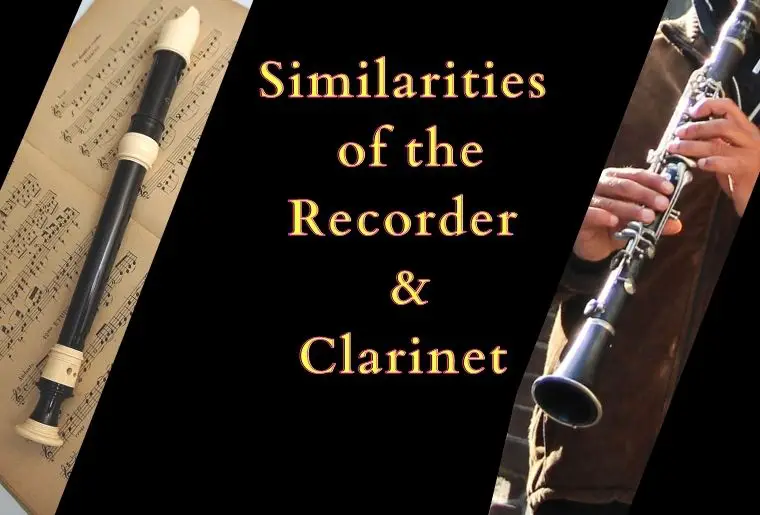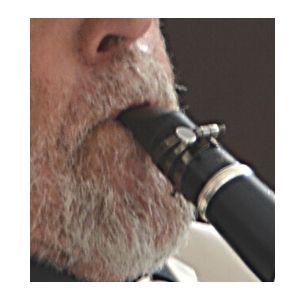At first glance, the recorder and clarinet look very different. However, there are many similarities between the two instruments. There are also many differences.
The clarinet and the recorder have many similarities. They both belong to the woodwind family. They are made of similar materials. Both are tubes and have several holes. Both have a range of sizes.
Both instruments have several differences as well. I have outlined these below so you can see where the two instruments are similar and where they are different.

Are The Recorder And Clarinet Similar
Yes, there are many ways the clarinet and the recorder are similar. Yet there are also quite a few differences between them as well.
Family Of Instrument
The recorder and clarinet are both in the same musical instrument family and are woodwind instruments
The Way You Blow

The recorder does not use a reed to create the sound a clarinet does. This affects how the air moves and the sound is created.
1.The recorder
The recorder is open on both ends. When you blow air into your recorder the air moves around the instrument. This causes it to vibrate which then causes the sound.

2. The clarinet
The clarinet has a reed that is attached to the mouthpiece. Air is then forced between the reed and the mouthpiece
The clarinet is closed off at the reed end. This creates a different effect and wavelength to the recorder.
Materials That Make the Recorder & Clarinet
Today the recorder is often made from plastic or wood and occasionally resin (a plant-based plastic). Traditionally it was made from wood or ivory.
The clarinet is also made from either plastic or wood. You can also get metal clarinets.
What Key Are Clarinets and Recorders in
The tuning is different between the two.
Recorders are tuned to the Key of F or C depending on which one you get.
Clarinets are usually in the Key B♭. You can get them in other keys such as A or E♭.
Keys V Holes
The standard recorders like the soprano and alto have holes and no keys. It’s only when you get to the larger instrument like the tenor and bass that you start to have keys at the bottom because the fingers won’t reach.
The clarinet has holes like the recorder only they are covered by keys.

The recorder has 8 holes seven in the front and one at the back for the thumb. The double holes at the bottom of the recorder are counted as one hole each and are in fact one hole on some instruments.
The clarinet has 11 holes and 17 keys.
Fingering The Recorder & Clarinet Is In Which in Key
Recorders have different fingering between different sizes for example the soprano and the tenor have C fingering and the Alto and Base have F fingering which makes swapping more difficult.
Whilst the fingering between the two are different some of the notes between the clarinet and the alto recorder are the same.
The keys/holes that are needed for each instrument to create the same note are sometimes the same depending on which recorder size you have and sometimes different. This can require some adjustment when changing instruments.
Clarinets are transposing instruments that have the same fingering regardless of size. This makes playing different clarinets easier.
Transposing or Non-Transposing Instrument
The recorder isn’t a transposing instrument, that is you can’t learn one fingering and use that for each recorder size ie the alto and tenor recorder fingerings are different.
The clarinet is a transposing instrument so even though the pitches are different for different size instruments the key fingering is the same so you don’t have to learn new notes.
Range Of Instruments
Typically a recorder can reach two octaves but pros can extend this.
The clarinet can reach four octaves according to Yamaha it is the only wind instrument that can reach such high notes (source)
Clarinet and Recorder Size Comparisons
Recorders vary in length from really tiny garklein recorders right up to the larger contrabass recorders. From about 6 inches to 6 feet and some even larger.
The clarinet also has different sizes. However, the most common clarinet is much larger than the popular recorder size. The soprano recorder is only about 11 -12 inches (30cm). While the soprano clarinet is larger than my also recorder at 26 inches long.
The shape of The Two Instruments
Typically both clarinets and recorders are long tubes with flared ends called the bell. The clarinets end flare is much larger than the recorders
Both the clarinet and the recorder come in several parts that are joined together to make the instrument. The recorder usually comes in three parts although it can be made from two or even only one piece.
Clarinets come in five pieces.
Weight Differences Between the Recorder and Clarinet
The weights of both instruments vary a lot depending on the materials they are made from and their size. Clarinets are typically heavier.
The Color of Recorders V Clarinet
Plastic recorders can come in any color even semi-see-through. Although the better quality ones tend to be the traditional recorder colors of brown and ivory expect the Ecodear from Yamaha which is cream.
Wooden recorders come in wood ranging from pale cream to darker mahogany types colors. You can get the actual wood color or have it stained.
Clarinets usually come in one color plastic – black! However, You can now get them in other colors such as red, blue, white, and green
The wooden clarinets are also dark. However, I have seen them in lighter wood colors as well.
These are the main colors you get. I have seen clarinets in other colors and materials but for the most part, this is what you can expect.
How Long Have The Recorder and Clarinet Been About?
The recorder dates back 42 to 43 thousand hears for the earliest very basic versions. The clarinet was invented in the 18th century By Johann Christoph Denner. Its predecessor was the Chalumeau. Which actually looks a lot like a recorder. Only like the clarinet it had a reed. Although the name does refer to several different instruments. (source).
